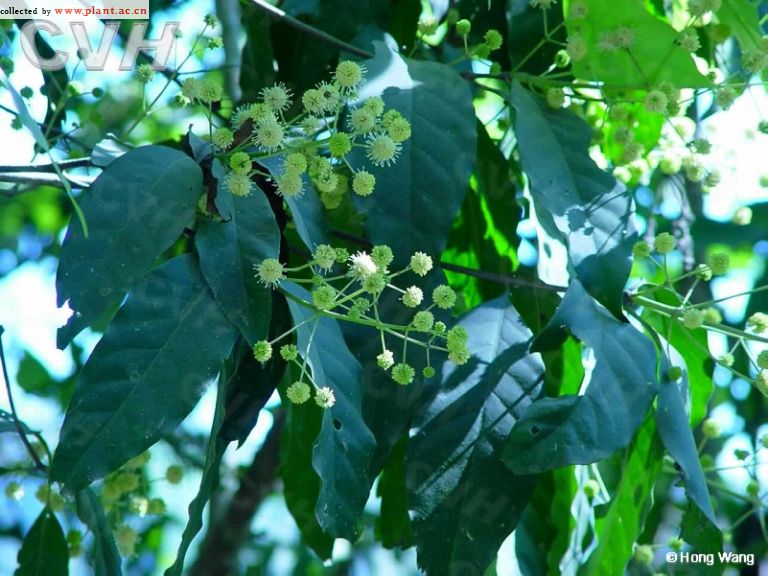锡金粗叶木Lasianthus sikkimensis Hook.
锡金粗叶木Lasianthus sikkimensis Hook.
8.锡金粗叶木(华南植物学报)图版21:6-11
Lasianthus sikkimensis Hook. f. Fl. Brit. Ind. 3: 180. 1880; Deb et Gang. in Journ. Econ. Tax. Bot. 15 (2): 297, fig. 9. 1991; Lo in Bot. Journ. South China 2: 3. 1993; H. Zhu in Acta Phytotax. Sinica 32 (1): 60. 1994. ——L. tsangii Merr. ex Li in Journ. Arn. Arb. 24: 457. 1943; 中国高等植物图鉴4: 756. 1975. ——L. koi auct. non Merr. et Chun: Metcalf in Journ. Arn. Arb. 26: 203. 1945.
灌木,高1-3米,除叶片上面、花冠和果实外全株被褐色绒毛或长柔毛;小枝近圆柱状,粗壮。叶纸质或近革质,长圆状披针形或近长圆形,有时狭披针形或近椭圆形,很少近卵形,长9-20厘米,宽2-6厘米,顶端渐尖或尾状渐尖,基部钝或圆,边全缘,常有缘毛,上面干时铅灰色,有时有光泽,下面褐色;中脉在上面常压入,下面凸起,侧脉每边约6-9条,上面可见,下面凸起,小脉近平行,上面不明显,下面凸起;叶柄粗壮,长通常不超过1厘米,密被硬毛;托叶不明显,隐于毛被中。花无梗,数朵至多朵簇生叶腋;苞片披针形,长1-1.5厘米左右,顶端渐尖、短尖或钻状,小苞片与苞片同形或钻形,长通常不超过1厘米;萼倒圆锥状,管长约2(-4)毫米,近无毛,裂片5,狭披针形,长约2- (3)毫米,渐尖,密被长缘毛;花冠白色(仅见花蕾),外面仅顶部疏被硬毛,里面被稀疏长柔毛,裂片5,近卵形,顶端内弯,有粗喙;雄蕊5,生冠管喉部,花丝短,花药椭圆形,长约1毫米,内藏;花柱伸至冠管喉部,内藏,柱头5裂,裂片线形。核果球形,径约4-4.5毫米,成熟时蓝色,无毛,顶冠以5片密被长硬毛、长约1.5-2毫米的宿萼裂片,含5个分核。花期10-12月,果期翌年7-8月。
产广东北部(英德)和西部、广西中部以南、云南河口和西藏墨脱。常生密林下。分布于印度东北部、锡金和孟加拉国。
《Flora of China》 Vol. 19 (2011)
Lasianthus sikkimensis J. D. Hooker Fl. Brit. India. 3: 180. 1880.
锡金粗叶木 xi jin cu ye mu
Lasianthus langkokensis Drake ex Pitard; L. sikkimensis subsp. langkokensis (Drake ex Pitard) H. Zhu; L. tsangii Merrill ex H. L. Li.
Shrubs, 1-3 m tall; branches and branchlets densely brown tomentose or -villous. Petiole 6-14 mm, densely tomentose to villous; leaf blade subleathery or thinly leathery, elliptic-lanceolate or elliptic, 12-20 × 2.5-5 cm, glabrous adaxially, densely to moderately brown tomentose or villous to hirtellous abaxially, base acute or obtuse, margin usually thinly recurved, apex cuspidate-acuminate; lateral veins 8-10 pairs; midrib and nerves elevated conspicuously abaxially; nervules subparallel, conspicuous abaxially; stipules generally persistent, triangular, 2-3 mm, densely tomentose to villous. Inflorescences glomerulate, sessile, 1-3-flowered, densely strigose to villous; bracts persistent, linear to lanceolate, 0.3-2 cm. Flowers sessile or subsessile. Calyx with hypanthium portion obconic, 1-2 mm, glabrous; limb 1-2 mm, hirtellous to strigillose, 5-lobed; lobes triangular. Corolla ca. 1 cm, puberulent outside. Fruit ellipsoid, 6-8 mm, glabrous, smooth or with ca. 5 low ridges; pyrenes 5. Fr. Jun, Oct.
Forests, shaded and wet places; 300-1600 m. Fujian, Guangdong, Guangxi, Taiwan, Yunnan, Zhejiang [Bangladesh, NE India, Philippines, Thailand, N Vietnam].
The combination of the glabrous fruit body and densely pubescent persisting calyx limb and the well-developed bracts on the sessile glomerulate inflorescences are distinctive for this species. H. Zhu (Syst. & Geogr. Pl. 72: 80. 2002) noted that the two subspecies of Lasianthus sikkimensis that were previously recognized have become difficult or impossible to separate now that more collections are available. Zhu (loc. cit.: 79) also noted that this species is very similar to L. schmidtii.The combination of the glabrous fruit body and densely pubescent persisting calyx limb and the well-developed bracts on the sessile glomerulate inflorescences are distinctive for this species. H. Zhu (Syst. & Geogr. Pl. 72: 80. 2002) noted that the two subspecies of Lasianthus sikkimensis that were previously recognized have become difficult or impossible to separate now that more collections are available. Zhu (loc. cit.: 79) also noted that this species is very similar to L. schmidtii.
别名:西南粗叶木;粗叶木;锡金鸡屎藤;上思粗叶木;臭屁树;
科名:茜草科 Rubiaceae
属名:粗叶木属 Lasianthus

8.锡金粗叶木(华南植物学报)图版21:6-11
Lasianthus sikkimensis Hook. f. Fl. Brit. Ind. 3: 180. 1880; Deb et Gang. in Journ. Econ. Tax. Bot. 15 (2): 297, fig. 9. 1991; Lo in Bot. Journ. South China 2: 3. 1993; H. Zhu in Acta Phytotax. Sinica 32 (1): 60. 1994. ——L. tsangii Merr. ex Li in Journ. Arn. Arb. 24: 457. 1943; 中国高等植物图鉴4: 756. 1975. ——L. koi auct. non Merr. et Chun: Metcalf in Journ. Arn. Arb. 26: 203. 1945.
灌木,高1-3米,除叶片上面、花冠和果实外全株被褐色绒毛或长柔毛;小枝近圆柱状,粗壮。叶纸质或近革质,长圆状披针形或近长圆形,有时狭披针形或近椭圆形,很少近卵形,长9-20厘米,宽2-6厘米,顶端渐尖或尾状渐尖,基部钝或圆,边全缘,常有缘毛,上面干时铅灰色,有时有光泽,下面褐色;中脉在上面常压入,下面凸起,侧脉每边约6-9条,上面可见,下面凸起,小脉近平行,上面不明显,下面凸起;叶柄粗壮,长通常不超过1厘米,密被硬毛;托叶不明显,隐于毛被中。花无梗,数朵至多朵簇生叶腋;苞片披针形,长1-1.5厘米左右,顶端渐尖、短尖或钻状,小苞片与苞片同形或钻形,长通常不超过1厘米;萼倒圆锥状,管长约2(-4)毫米,近无毛,裂片5,狭披针形,长约2- (3)毫米,渐尖,密被长缘毛;花冠白色(仅见花蕾),外面仅顶部疏被硬毛,里面被稀疏长柔毛,裂片5,近卵形,顶端内弯,有粗喙;雄蕊5,生冠管喉部,花丝短,花药椭圆形,长约1毫米,内藏;花柱伸至冠管喉部,内藏,柱头5裂,裂片线形。核果球形,径约4-4.5毫米,成熟时蓝色,无毛,顶冠以5片密被长硬毛、长约1.5-2毫米的宿萼裂片,含5个分核。花期10-12月,果期翌年7-8月。
产广东北部(英德)和西部、广西中部以南、云南河口和西藏墨脱。常生密林下。分布于印度东北部、锡金和孟加拉国。
《Flora of China》 Vol. 19 (2011)
Lasianthus sikkimensis J. D. Hooker Fl. Brit. India. 3: 180. 1880.
锡金粗叶木 xi jin cu ye mu
Lasianthus langkokensis Drake ex Pitard; L. sikkimensis subsp. langkokensis (Drake ex Pitard) H. Zhu; L. tsangii Merrill ex H. L. Li.
Shrubs, 1-3 m tall; branches and branchlets densely brown tomentose or -villous. Petiole 6-14 mm, densely tomentose to villous; leaf blade subleathery or thinly leathery, elliptic-lanceolate or elliptic, 12-20 × 2.5-5 cm, glabrous adaxially, densely to moderately brown tomentose or villous to hirtellous abaxially, base acute or obtuse, margin usually thinly recurved, apex cuspidate-acuminate; lateral veins 8-10 pairs; midrib and nerves elevated conspicuously abaxially; nervules subparallel, conspicuous abaxially; stipules generally persistent, triangular, 2-3 mm, densely tomentose to villous. Inflorescences glomerulate, sessile, 1-3-flowered, densely strigose to villous; bracts persistent, linear to lanceolate, 0.3-2 cm. Flowers sessile or subsessile. Calyx with hypanthium portion obconic, 1-2 mm, glabrous; limb 1-2 mm, hirtellous to strigillose, 5-lobed; lobes triangular. Corolla ca. 1 cm, puberulent outside. Fruit ellipsoid, 6-8 mm, glabrous, smooth or with ca. 5 low ridges; pyrenes 5. Fr. Jun, Oct.
Forests, shaded and wet places; 300-1600 m. Fujian, Guangdong, Guangxi, Taiwan, Yunnan, Zhejiang [Bangladesh, NE India, Philippines, Thailand, N Vietnam].
The combination of the glabrous fruit body and densely pubescent persisting calyx limb and the well-developed bracts on the sessile glomerulate inflorescences are distinctive for this species. H. Zhu (Syst. & Geogr. Pl. 72: 80. 2002) noted that the two subspecies of Lasianthus sikkimensis that were previously recognized have become difficult or impossible to separate now that more collections are available. Zhu (loc. cit.: 79) also noted that this species is very similar to L. schmidtii.The combination of the glabrous fruit body and densely pubescent persisting calyx limb and the well-developed bracts on the sessile glomerulate inflorescences are distinctive for this species. H. Zhu (Syst. & Geogr. Pl. 72: 80. 2002) noted that the two subspecies of Lasianthus sikkimensis that were previously recognized have become difficult or impossible to separate now that more collections are available. Zhu (loc. cit.: 79) also noted that this species is very similar to L. schmidtii.

